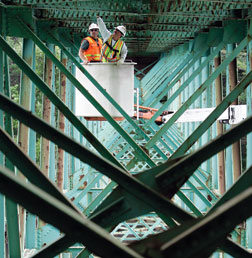...inspection contractor, inspect the bridge. The 112-year-old structure is restricted to 13 tons and is scheduled for a $21-million demolition and replacement, starting in 2012, says Gomes.
In Ohio, the public was reminded about another steel deck-truss bridge that sagged during repainting 10 years ago due to failing gusset plates. It carries I-90 eastbound over the Grand River near Cleveland in Lake County.
 AP
|
The bridge slumped while being shot-blasted for painting. The failure occurred at the gusset plates, which investigators found had corroded from salt water running down the diagonals. The blasting weakened the gussets to failure.
“It was not a catastrophic failure, but enough that it was a safety concern,” says Scott Varner, ODOT spokesman. ODOT closed the bridge, reinforced the gussets, and reopened the road. The investigators concluded that the failure was peculiar to the circumstances and did not call for special attention to the design. . But the incident has been added in the last five years to the standard training for ODOT bridge engineers.
 AP Thompson Run Bridge in Monroeville, Pa., gets an exam from PennDOT (top right), while Maine transportation engineers check bridges of their own (above).
|
“We talk about gussets and refer to the 1996 incident,” says Varner. Bridge inspectors now are revisiting seven of the 12 ODOT-maintained bridges. “What we’re looking at is the structural steel,” says Tim Keller, ODOT’s state bridge engineer. “We put no more focus on the gusset plates than we do at any other part.”
Sixteen Ohio bridges use the same deck-truss design as I-35W. The Ohio DOT is responsible for 12 of them. Counties own three others and a municipality owns a fourth.
Illinois DOT has for the past two years required bridge repair contractors to have construction load reviews by a licensed structural engineer. “If it is a fairly straight-forward bridge, we tend to not require this provision,” says Ralph Anderson, IDOT’s bridge engineer. But for bridges “in fairly poor health...don’t assume that the plans are trying to cover everything.”
In light of gusset plate design concerns raised by FHWA, Greg Bailey, director of the Engineering Division at West Virginia Dept. of Transportation, says his inspectors will focus particularly on gussets that are “fracture critical” or have fatigue cracks. “Obviously, with what happened in Minnesota, our inspectors are going to make sure they really do look at those areas and make sure nothing was missed,” he says.
Bailey says WVDOT has received no special guidance from FHWA of how to inspect those gussets, outside of existing National Bridge Inspection Standards regulations. Other than accelerating its schedule on its deck truss bridges, Bailey says the state is not adjusting its priorities yet.
The state of Oregon is completing visual inspections of 46 steel truss bridges by August 29, at an estimated cost of $500,000. To date the only unexpected damage were small fatigue fractures on secondary members of the Marquam Bridge over the Willamette River in Portland. “We will monitor these closely,” says Bruce Johnson, Oregon state bridge engineer.
State DOTs are eagerly awaiting reports from the investigation of I-35W, and the engineers don’t feel they can do more at this time. “Ultimately there will be a finding and then we’ll have to go back and make sure that we have accounted for that finding in our program and how we inspect our bridges,” says WVDOT’s Bailey.
“That’s more of a long-term issue. You learn from things like this. We’ll want to apply the lessons learned to make sure we account for that, but what those lessons would be is speculative at this point,” Bailey says.
Moves to line up political support for funding a national repair and reconstruction program swiftly hit a wall of partisan politics. House Transportation and Infrastructure Committee Chairman James Oberstar (D-Minn.) proposed a new trust fund. “If we don’t want another I-35 bridge collapse, we have to address that portfolio of deficient, structurally failing bridges,” Oberstar says. Possible funding sources could include a fuel-tax hike.
But a day later, President George W. Bush and others blasted the plan as a poor way to set priorities to spend the public money.

Post a comment to this article
Report Abusive Comment